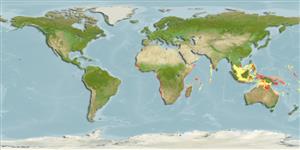Common names from other countries
>
Eupercaria/misc (Various families in series Eupercaria) >
Sciaenidae (Drums or croakers)
Etymology: Atractoscion: Greek, atraktos, arrow + Greek, skion, skiaina = barbel, red mullet (Ref. 45335).
More on author: Cuvier.
Environment: milieu / climate zone / depth range / distribution range
Ecologia
marinhas bentopelágico; intervalo de profundidade 15 - 200 m (Ref. 3593), usually 100 - 200 m (Ref. 3593). Tropical; 14°N - 28°S
Western Indian Ocean: off Mozambique and South Africa.
Length at first maturity / Tamanho / Peso / Idade
Maturity: Lm ?, range 65 - ? cm
Max length : 130 cm TL macho/indeterminado; (Ref. 4373); common length : 90.0 cm SL macho/indeterminado; (Ref. 9772); peso máx. Publicado: 25.0 kg (Ref. 4373)
Espinhos dorsais (total): 10 - 11; Raios dorsais moles (total): 25-32; Espinhos anais 2; Raios anais moles: 9 - 10. Body silvery (Ref. 4373).
Found in coastal waters, over sand muddy bottom. Juveniles enter estuaries. Adults feed on pelagic fishes at night. Often caught with Umbrina canariensis. Feeds on pelagic fish such as mackerel and horse mackerel (Ref. 36731). Marketed fresh, flesh highly esteemed (Ref. 9772).
Life cycle and mating behavior
Maturidade | Reprodução | Desova | Ovos | Fecundidade | Larvas
Chao, L.N. and E. Trewavas, 1990. Sciaenidae. p. 813-826. In J.C. Quero, J.C. Hureau, C. Karrer, A. Post and L. Saldanha (eds.) Check-list of the fishes the eastern tropical Atlantic (CLOFETA). JNICT, Lisbon; SEI, Paris; and UNESCO, Paris. Vol. 2. (Ref. 3593)
Categoria na Lista Vermelha da IUCN (Ref. 130435)
CITES (Ref. 128078)
Not Evaluated
Ameaça para o homem
Harmless
Utilização humana
Pescarias: espécies comerciais; peixe desportivo: sim
Mais informação
ReferênciasAquaculturaPerfil para aquaculturaEstirpesGenéticaElectrophoresesHereditariedadeDoençasProcessamentoMass conversion
ColaboradoresFotografiasStamps, Coins Misc.SonsCiguateraVelocidadeTipo de nataçãoÁrea branquialOutras referênciasCérebrosVisão
Ferramentas
Relatórios especiais
Descarregue XML
Fontes da internet
Estimates based on models
Preferred temperature (Ref.
115969): 14 - 26.5, mean 18.7 (based on 131 cells).
Phylogenetic diversity index (Ref.
82804): PD
50 = 0.5312 [Uniqueness, from 0.5 = low to 2.0 = high].
Bayesian length-weight: a=0.00851 (0.00413 - 0.01752), b=3.08 (2.91 - 3.25), in cm Total Length, based on LWR estimates for this (Sub)family-body shape (Ref.
93245).
Nível Trófico (Ref.
69278): 4.5 ±0.80 se; based on food items.
Resiliência (Ref.
120179): Baixo, tempo mínimo de duplicação da população 4,5 - 14 anos (K=0.27; tm=5).
Fishing Vulnerability (Ref.
59153): Moderate to high vulnerability (51 of 100).
Climate Vulnerability (Ref.
125649): Very high vulnerability (83 of 100).
